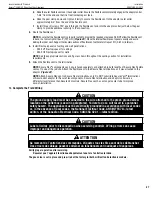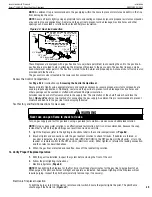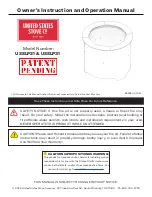
Installation
900475-00, 08/2015
Innovative Hearth Products
Aurora™ 35/40/45 Direct-Vent Gas Fireplaces
26
Vertical (Offset) Installation
1.
Analyze the vent route and determine the number of vent sections and elbows required
—See
Effective Vent
Length on Page 24
for more information. Plan the venting so that a joint does not occur in the ceiling or roof
joists. Allow for elbows (
Figures 23-24
). Maintain the minimum clearances for combustibles (
Page 25
).
2. Frame the ceiling opening
—Use a plumb line from the ceiling above the fireplace to locate the center of the
vertical run. Cut and/or frame an opening, 10-1/2 x 10-1/2” (267 x 267 mm) inside dimensions, about this center
mark (
Figure 19
).
Figure 19 - Framing the ceiling opening
Figure 20 - Rear vent gasket
Gasket
3. Install the rear vent gasket
—The rear vent gasket is factory installed and required for all rear vent applications.
If the gasket is missing, position a replacement gasket around the vent collar before attaching other vent
components to the fireplace (
Figure 20
). Loosely attach the gasket with two screws at the top and bottom.
4. Attach the vent components to the fireplace
—See
Connecting the vent pipe on Page 23
.
5. Attach the vent components to each other
—See
Connecting the vent pipe on Page 23.
6. Install firestop/spacer at ceiling
—When using Secure Vent
®
, use SV4.5VF firestop/spacer at ceiling joists; when
using Secure Flex
®
, use SF4.5VF firestop/spacer. If there is living space above the ceiling level, the firestop/
spacer must be installed on the bottom side of the ceiling. If attic space is above the ceiling, the firestop/spacer
must be installed on the top side of the joist. Route the vent sections through the framed opening and secure the
firestop/spacer with 8d nails or other appropriate fasteners at each corner.
Remember to maintain 1” (25 mm) clearance to combustibles, framing members, and attic or ceiling insulation
when running vertical chimney sections. The gap between the vent pipe and a vertical firestop can be sealed with
non-combustible caulking.
NOTE:
Attic Insulation Shield (H3907)
must be installed when blown or loose-fill insulation is used, and is
required for all attic installations.
7. Support the vertical vent run sections
—Support the vertical portion of the venting system every 8 ft (2.4 m)
above the fireplace vent outlet. One method of support is by utilizing field provided support straps (conventional
plumber’s tape). Secure the plumber’s tape to the framing members with nails or screws. Loop the tape around
the vent, securing the ends of the tape to the framing. If desired, sheet metal screws #6 x 1/2” length may be
used to secure the support straps to the vent pipe (
Figure 21
).
NOTE:
Proper venting support is very important.
Figure 21 - Supporting the Vertical Vent Run
Blocking
Support straps
(plumber’s tape)
8 ft (2.4 m)
maximum
1/2” (12.7
mm) minimum
clearance to
combustibles
minimum 10 1/2 in.
(267 mm)
minimum 10 1/2 in.
(267 mm)
Roof
Framing
Ceiling
Framing
Plumb Bob
10-1/2” (267 mm) minimum
10-1/2” (267 mm)
minimum
















































